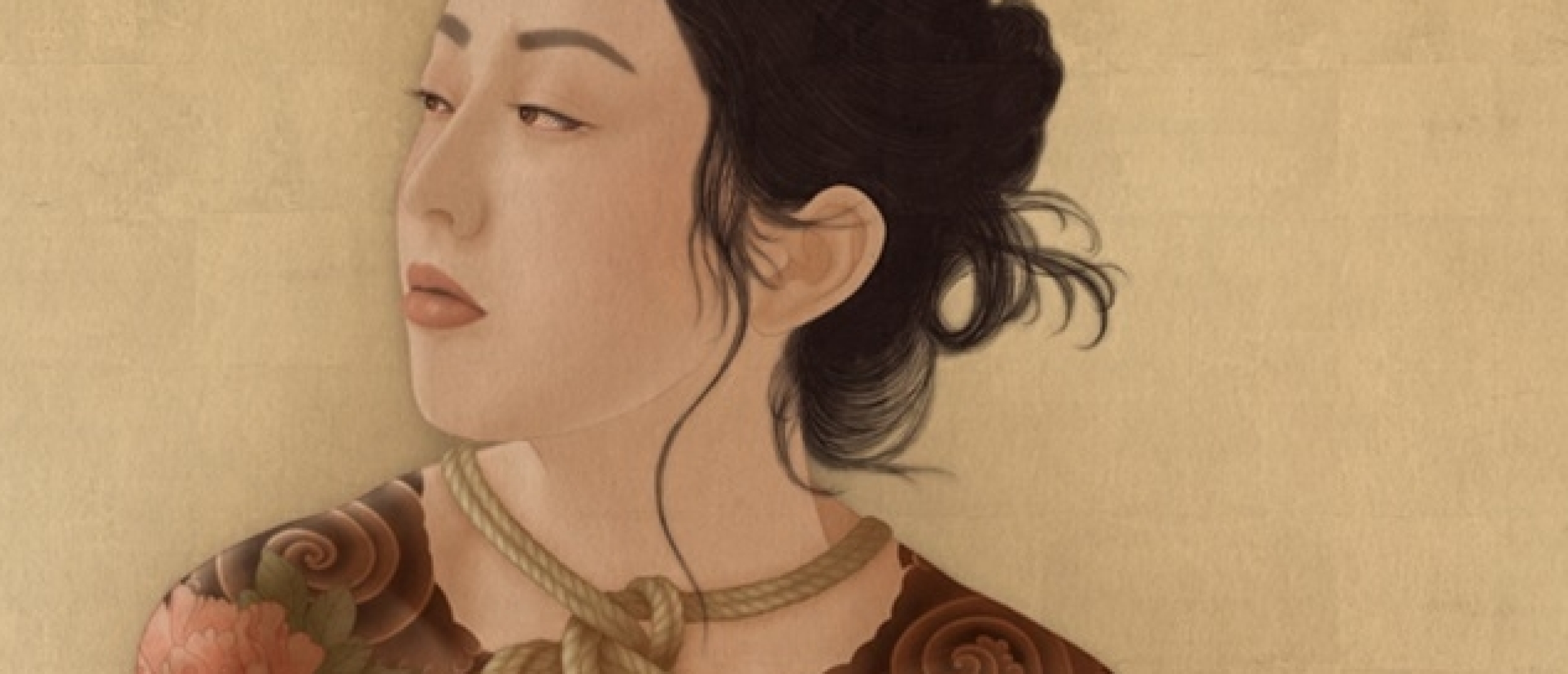
Following on from his shunga series 36 Views of Mount Fuji (2022/2023), the Swedish artist Senju Shunga has started a new series that will again consist of 36 designs. The artist explains:
“Hatsu” is the first of 36 prints in my latest series titled “Edo no Shana (Flowers of Edo)”, and marks yet another step forward in the way I create art. Within Japanese Ukiyo-e (pictures of the floating world), there is a genre called “Bijinga (portraits of beautiful women)” and it's closely connected with the more explicit “shunga” genre. Loose shunga prints were often collected in albums, where the collector could construct his or hers personal little fantasy.
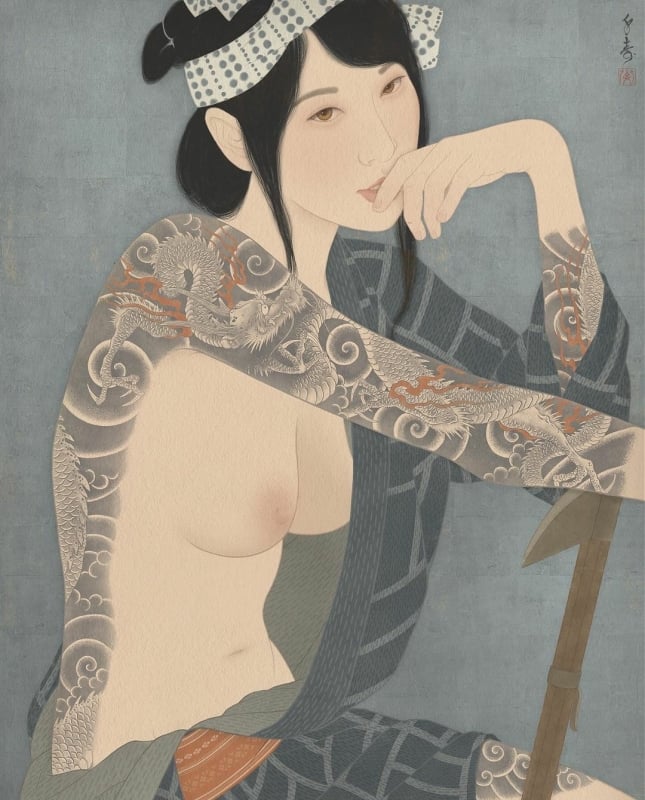
Fig.1. Hatsu ( Oct 2023)
Firefighter
Many times, these albums had Bijinga prints glued in on the first couple of pages, perhaps to create a more real sensation when viewing the prints for personal pleasure. So, naturally, I want to challenge myself with creating a collection of Bijinga. The keywords tonthia collection will be subtleties and a lot of playing with the historical roles of women and men during the Edo period. “Hatsu” is a Hikeshi, a firefighter. A very masculine profession in those days, and I have never heard of any female Hikeshi as of yet.
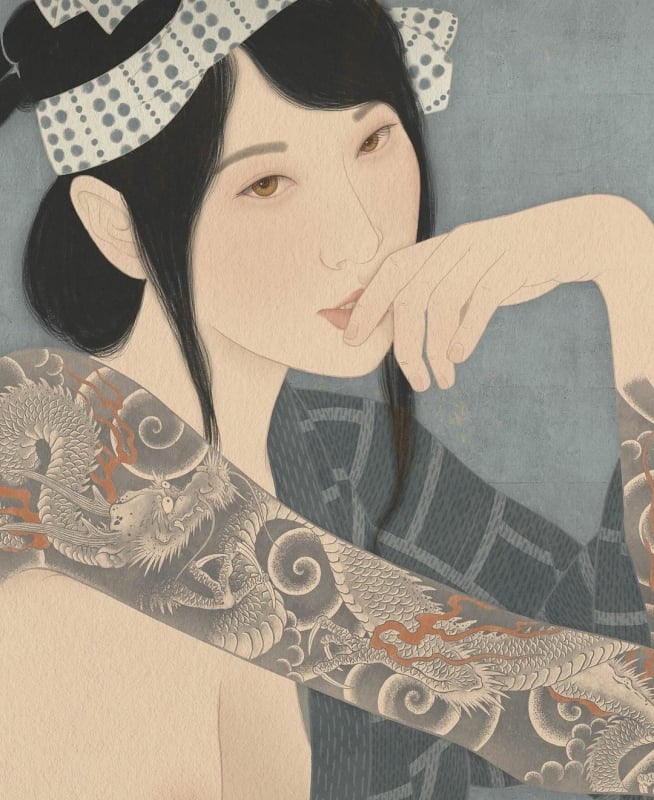
Fig.1a. Detail close-up
Rowdy
The Edo firefighters had a very short life expectancy and where regarded as heroes, even though their rowdy and uncompromising lifestyle perhaps terrified and bothered the common folk and samurai class likewise. The next print will be of a famous Kabuki character, and equally rowdy person -Benten Kozo."
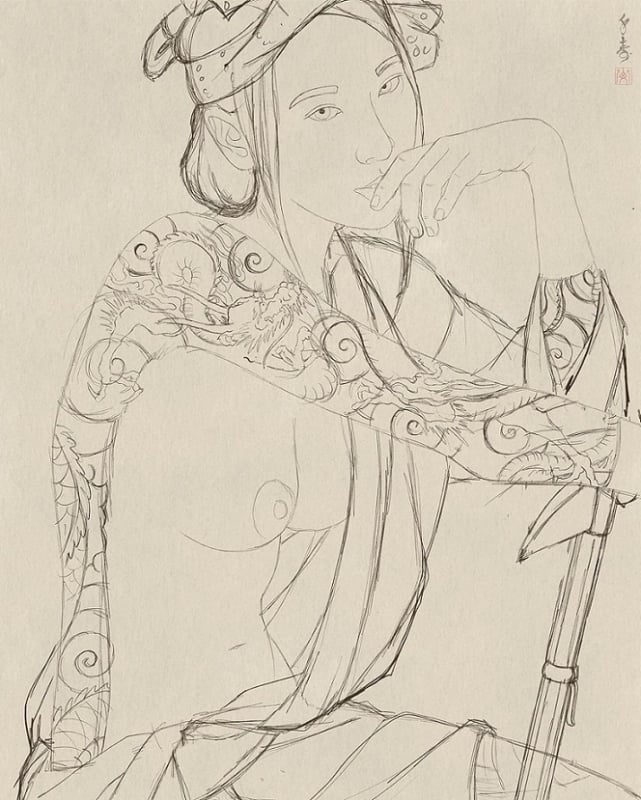
Fig.1b. Preliminary drawing
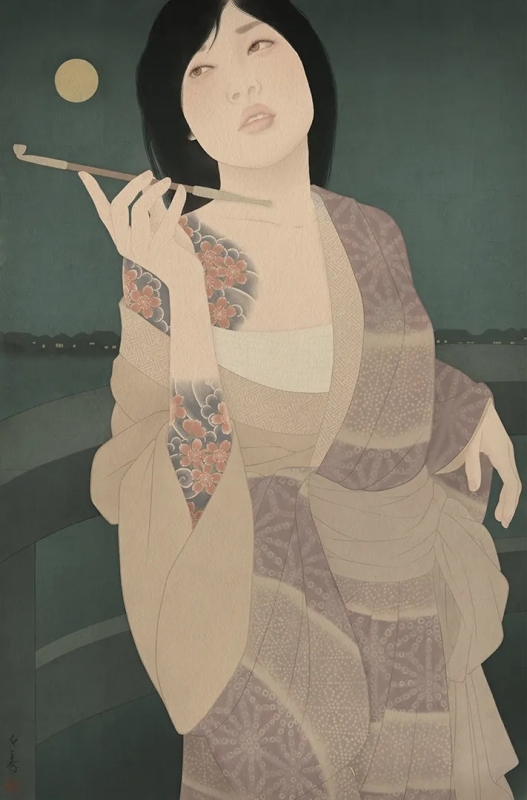
Fig.2. Benten Kozo (Oct 2023)
Five Men of the White Waves
Can we trust our own eyes? For my second painting in the ”Flowers of Edo” series, I have chosen to portray the Japanese Kabuki theatre character Benten Kozo. In the famous play "Shiranami Gonin Otoko" (Five Men of the White Waves) Benten Kozo is a gizoku (honorable thief) with the ability and skill to disguise himself as a beautiful woman. For a long time I have been contemplating the idea that perhaps Benten Kozo could instead be a beautiful woman with the ability to pose as a man. Wouldn’t that be a truly interesting twist to the already very interesting and exiting drama? I have placed Benten Kozo on the famous Ryogoku bridge in Edo (now Tokyo). This iconic bridge was featured in the 2015 anime film ”Miss Hokusai”. A personal favorite of mine that I recommend you to see!
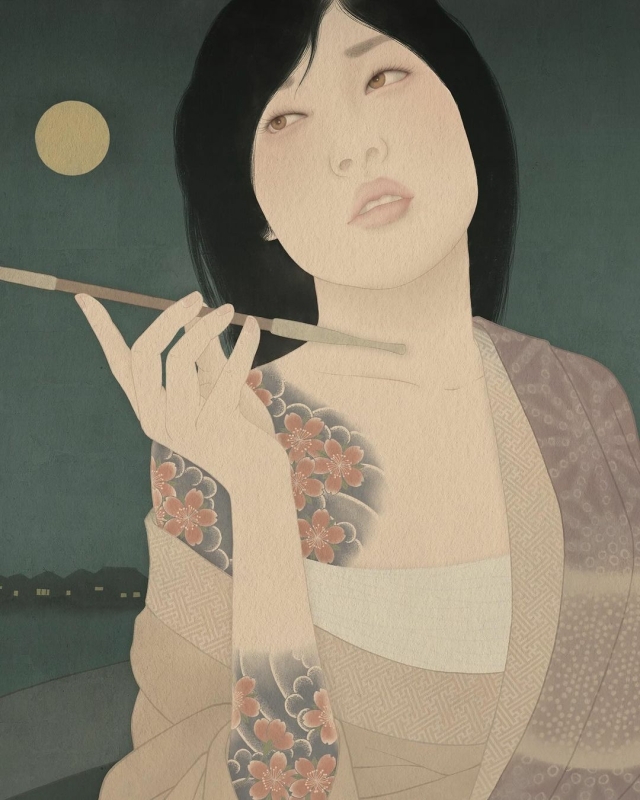
Fig.2a.
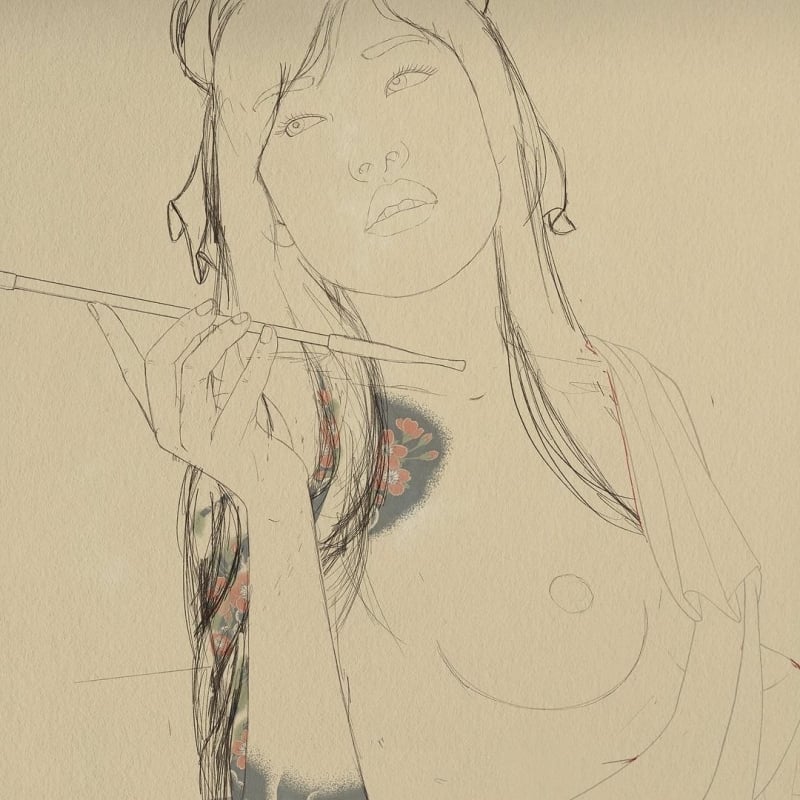
Fig.2b.
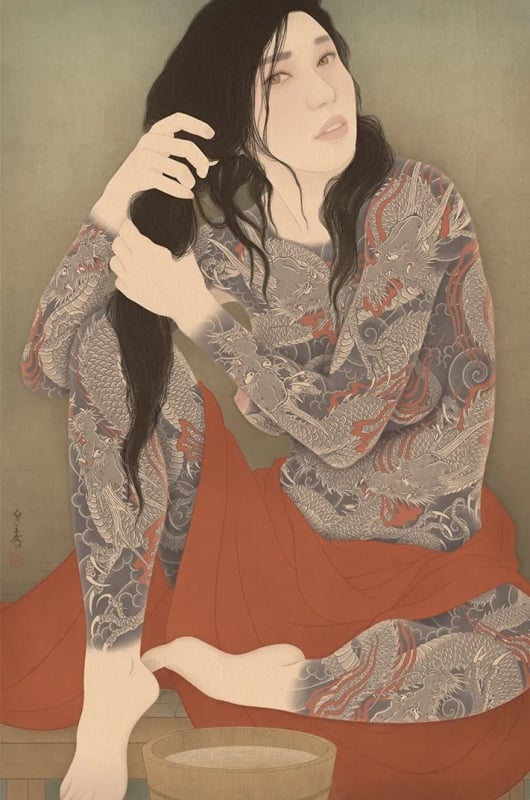
Fig.3. Kumonryu (9 dragons) (Nov 2023)
9 Dragons
“Kumonryu” (9 dragons) is the latest painting in my new ongoing series “Edo no hana” (flowers of Edo). I had a great time reconnecting with my early days of being a tattooer of traditional Irezumi body suits. In the beginning of my career, I spent countless hours sketching dragons. In my opinion, Japanese dragons are the hardest to do justice, alongside shishi (lions) and koi (carp). Being three of the basic designs in irezumi they nevertheless require a lifetime to master. And for this female version of the famous chinese outlaw hero Kumonryu, I had to design no less than eight different dragons (the ninth one is on her back and therefore not visible). There are still 33 portraits of beautiful women to create before this series reaches its conclusion, and I am now realizing how much of challenge this will be
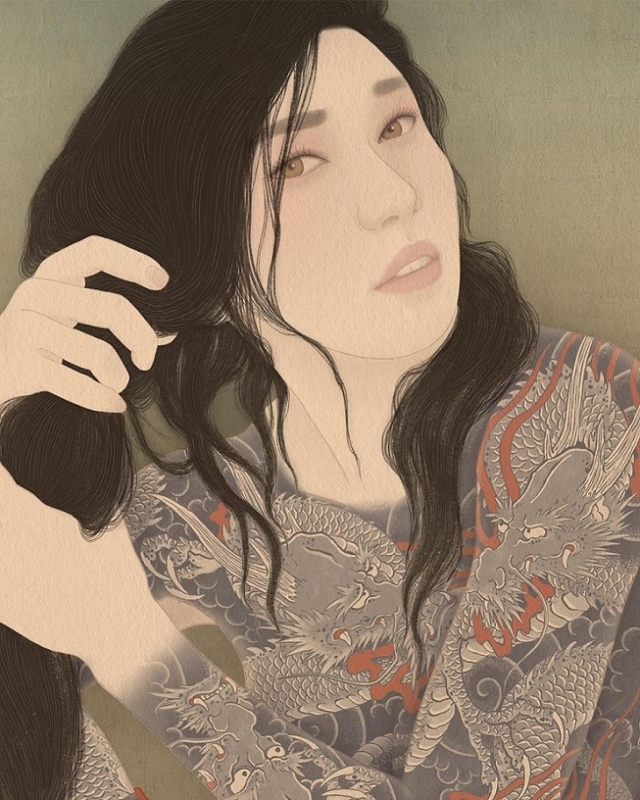
Fig.3a.
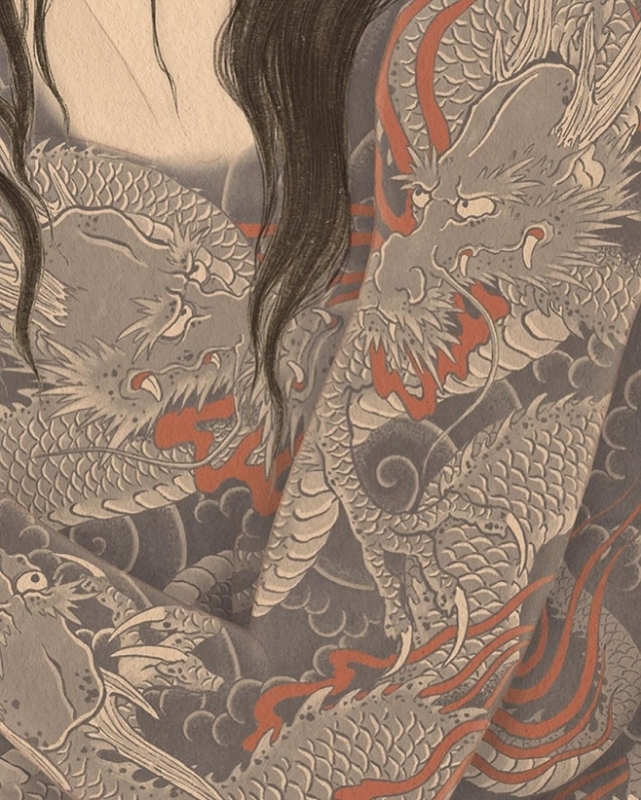
Fig.3b.
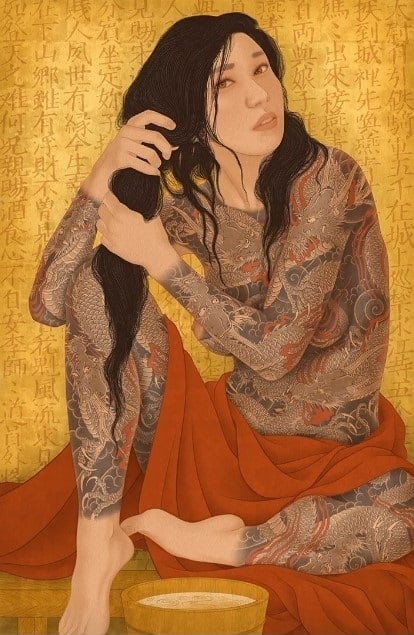
Fig.3c Alternative version
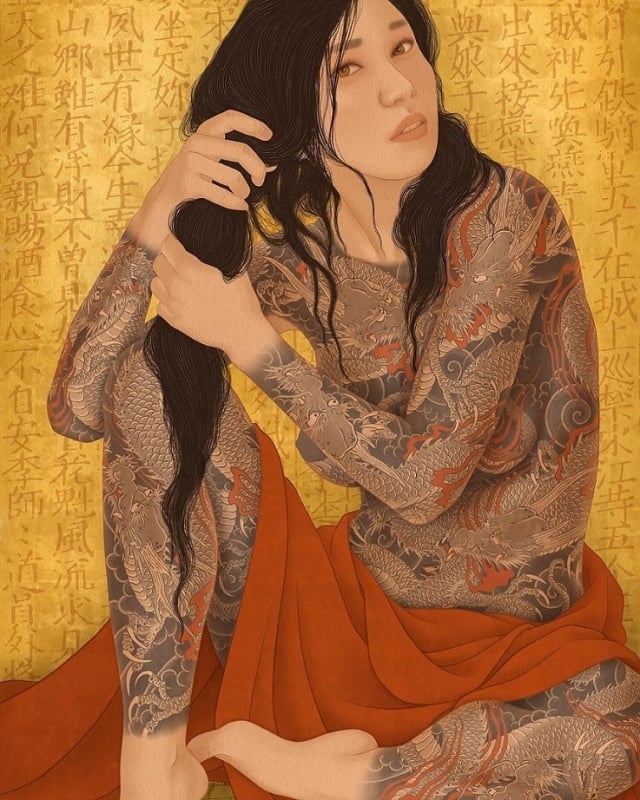
Fig.3d.
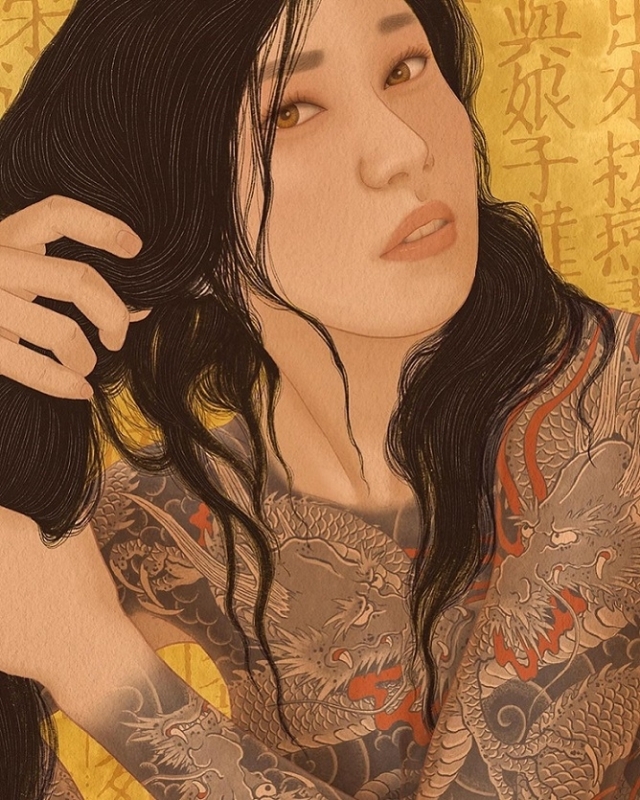
Fig.3e.
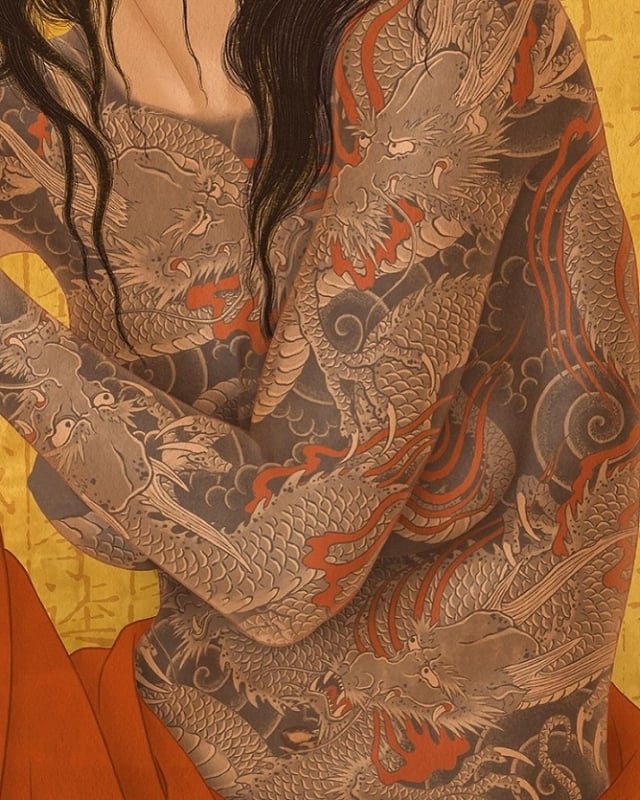
Fig.3f
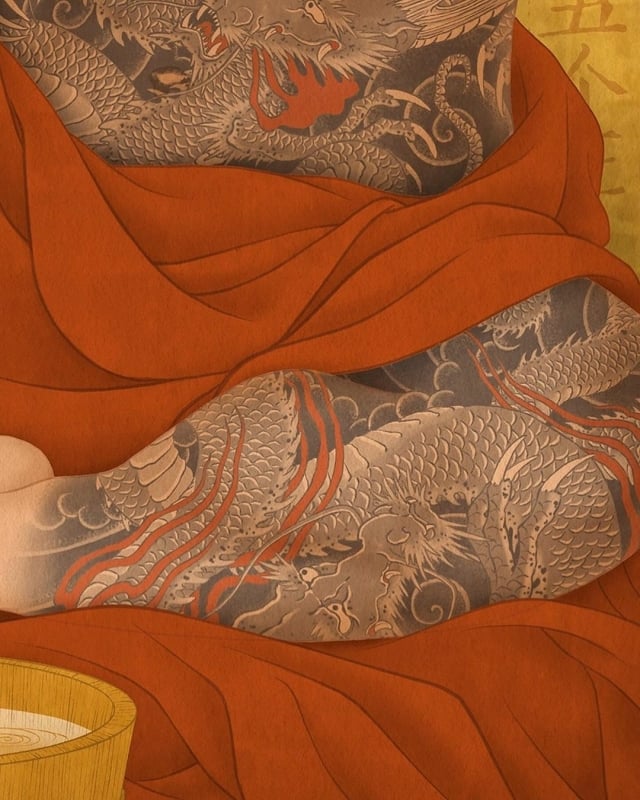
Fig.3g
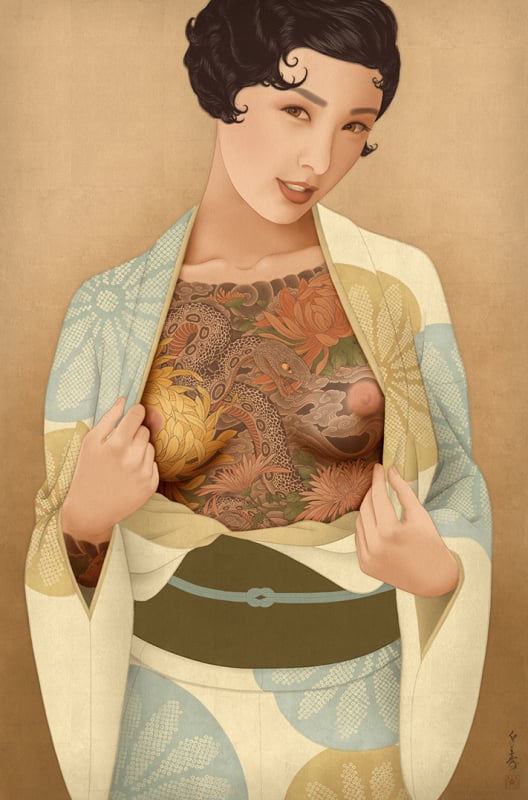
Fig.4. Okiku (March 2024)
Dark and Sinister
Is my art poison for the mind? Or have religious moral delusions been infecting the world for thousands of years, and twisted what is natural and beautiful into something dark and sinister? I know the answer and I am sure you do too.
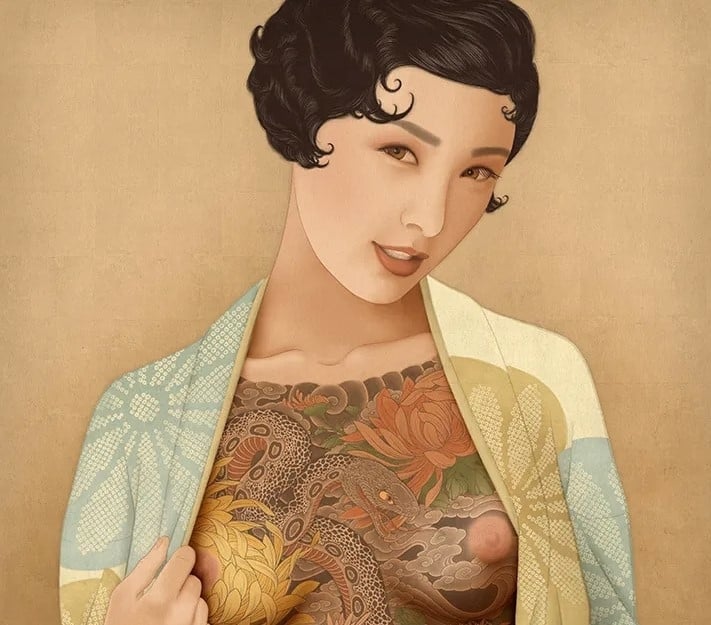
Fig.4a
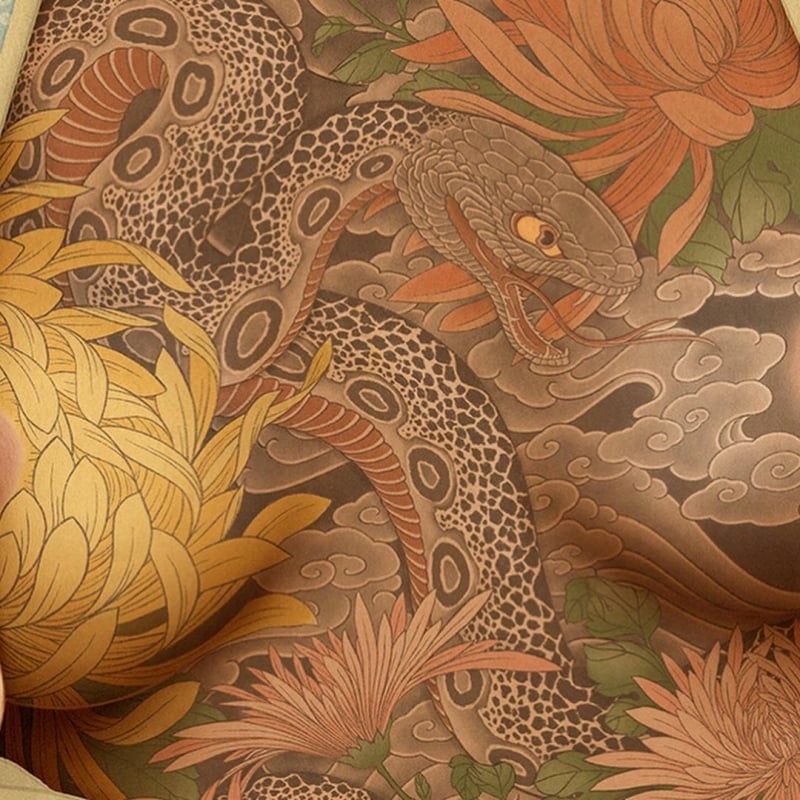
Fig.4b
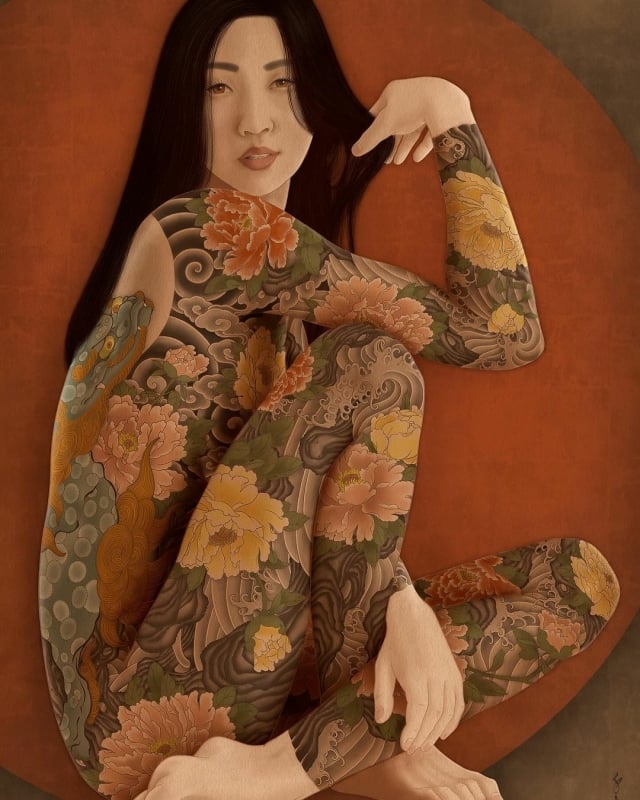
Fig.5. "Chiyo" (March 2024)
Learning Experience
You can’t hurry art. Human time is only a concept. At first, it seems strange, that the more skillful and experienced I become as an artist, the longer each painting takes to create. Shouldn’t it be the other way around? Thankfully, that is not the truth. The more I know and understand, about creating art, about myself and about the world, the larger the universe of painting becomes. Each work is a learning experience and an obstacle to overcome. Success in completing one painting in a satisfactory way will leave me with more and new skills, tools and insights, so the following piece is always started at a level I haven’t quite reached yet.
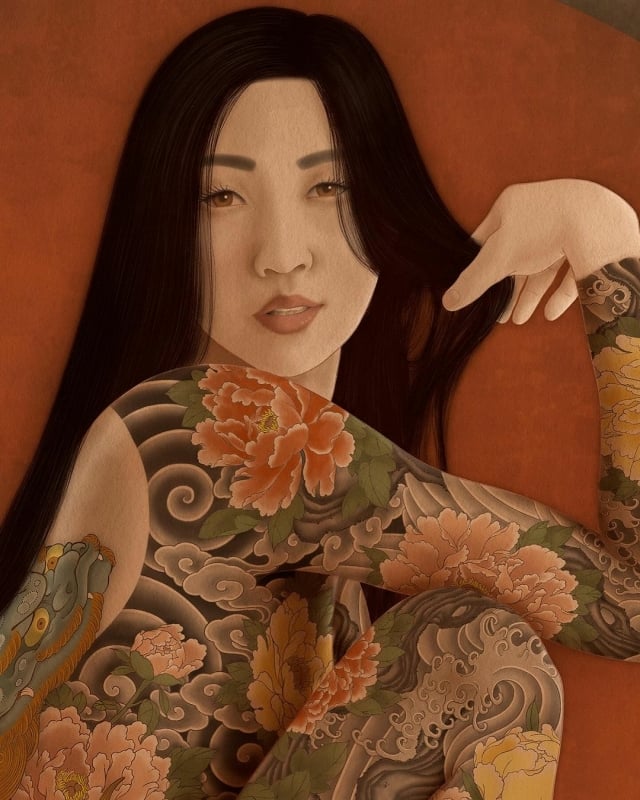
Fig.5a
Snail
Some years ago, I would be frustrated if a painting dragged on for weeks and months. Today, I know that there is no such thing as fast or slow when it comes to creating. Each artwork will take exactly as long as it takes. No shorter and no longer. One of the reasons artist’s might feel they are ”failing” a painting, is because they simply haven’t worked the neccessary time required for a particular piece. Don’t stop! Continue, continue, continue and you will get there! If a snail sets out for Mount Fuji, surely it will get there!
Coffee Breaks
Please keep in mind that coffee breaks, research, looking at art, reading, having a beer, walking the dog or cooking can be equally important as putting pen and brush to paper and canvas. Just don’t let the work completely out of your mind and never give up. Continue or start over and then move straight ahead! All the masterpieces of art took exactly the right amount of time to be completed. It could be five hours or five years. You can only know when arrive at the journey’s end. Time is a concept. For this latest painting, ”Chiyo”, I spent at least 4-5 intense hours a day for about 2 weeks just for the tattoo. Coming up with the simple background took 3 days of experimenting and starting over. Painting it took half a day. was that slow or quick? Yes, it was.
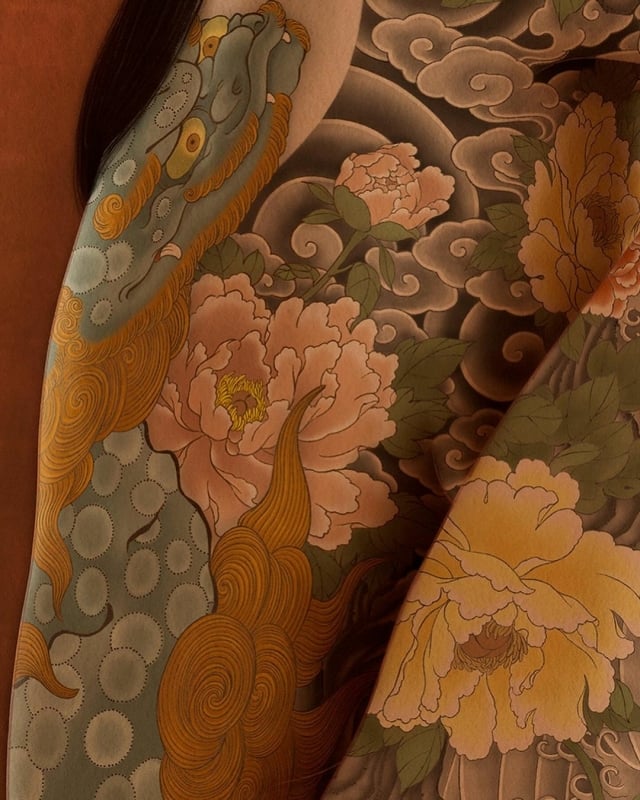
Fig.5b
Bodysuit Tattoo
The following pics (Fig.7c to f) show the various steps for painting Irezumi, the traditional Japanese tattoo! Creating a full bodysuit tattoo like this ”Karajishi botan (chinese lion with peonies)” design is truly like creating a whole other painting within the painting. If you want to do it right, there can be no rush in designing it, as even one small corner being done in haste would ultimately ruin the whole composition. Even with my 24 years experience in designing for Irezumi, a piece like this is incredibly difficult to create.
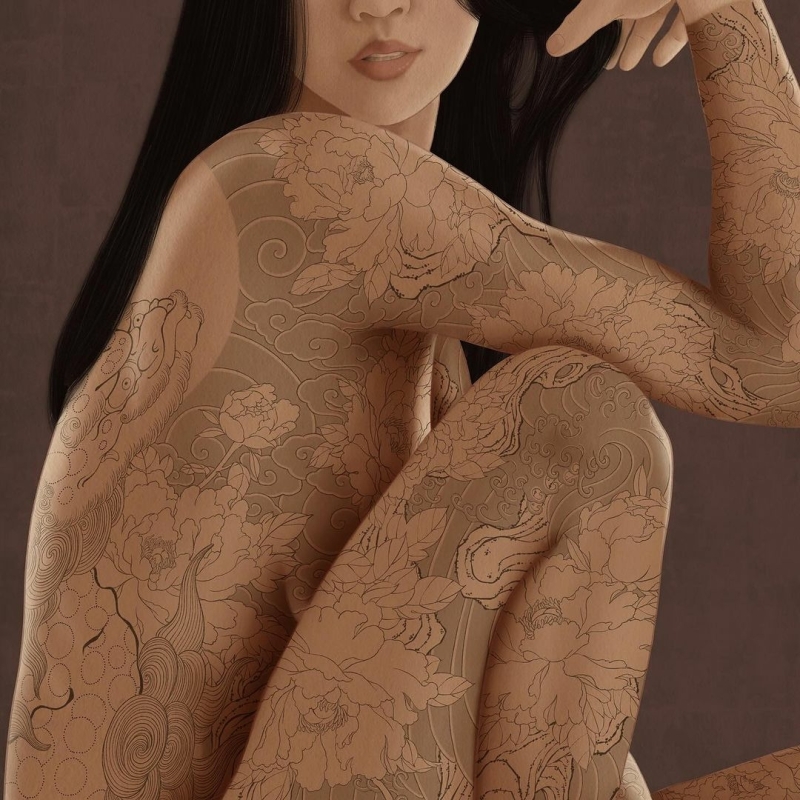
Fig.5c
Horishi
Of course, compared to creating it on a living , breathing client, there is some relief in not having to deal with the person bleeding and moving around because of the pain from the needles. And I can go back and change it over and over until I reach the desired result, something which of course would be impossible once the ink is inserted into the client’s skin. I am enjoying creating this series of tattooed beauties on so many levels. Not only do I get to constanly work on my skillset as a painter, but I also get to evolve as a horishi ( a traditional Japanese tattoo artist). It’s beyond exiting to notice how all these years of intense studies and constant work seems to be coming full circle!
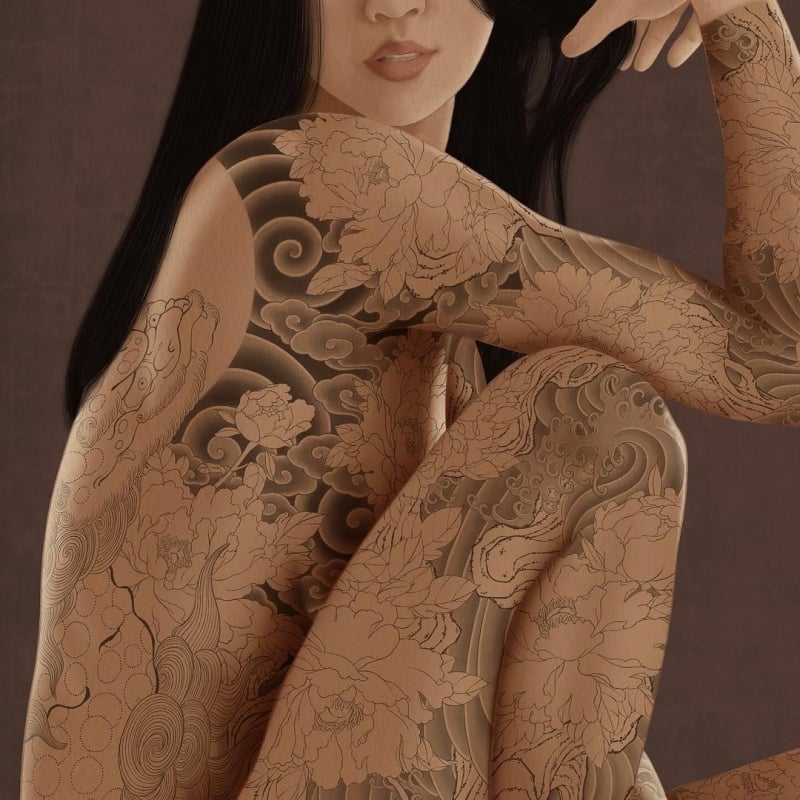
Fig.5d

Fig.5e

Fig.5f
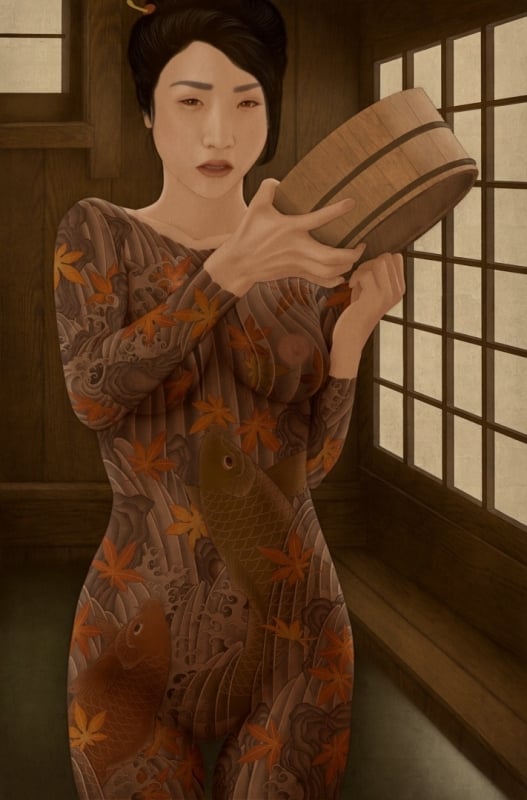
Fig.6. "Aki" (Apr 2024)
Climbing Koi
The legend behind the koi (carp) climbing the waterfall in autumn refers is called ”Touryuumon” in Japanese. It is a Chinese folk story about a Koi going back upstream to spawn when the momiji (autumn leaves) are falling.
This is natural behavior. among many different kinds of fish. However, when he reaches the mighty waterfall called Long men (Dragon’s gate), he is unable to ascend it. After many failed attempts, the exhausted koi puts his everything into one final, desperate jump. At last, he is able to conquer the waterfall, but due to fatigue, he has to pay dearly for his victory. He dies.
The Chinese gods in heaven have taken notice of the koi’s bravery and perserverance and rewards him by transforming him into a mighty dragon!
In xen buddhism, the koi’s continous struggle to scale the waterfall is likened to the practise of zazen (seated silent meditation) and the koi’s death and subsequent transformation can be seen as finally reaching satori (enlightment/liberation).
To design a tradtional irezumi full body tattoo with this theme has been nurtured in my mind for years, and now I, just like the koi, took a giant leap and saw it through all the way.
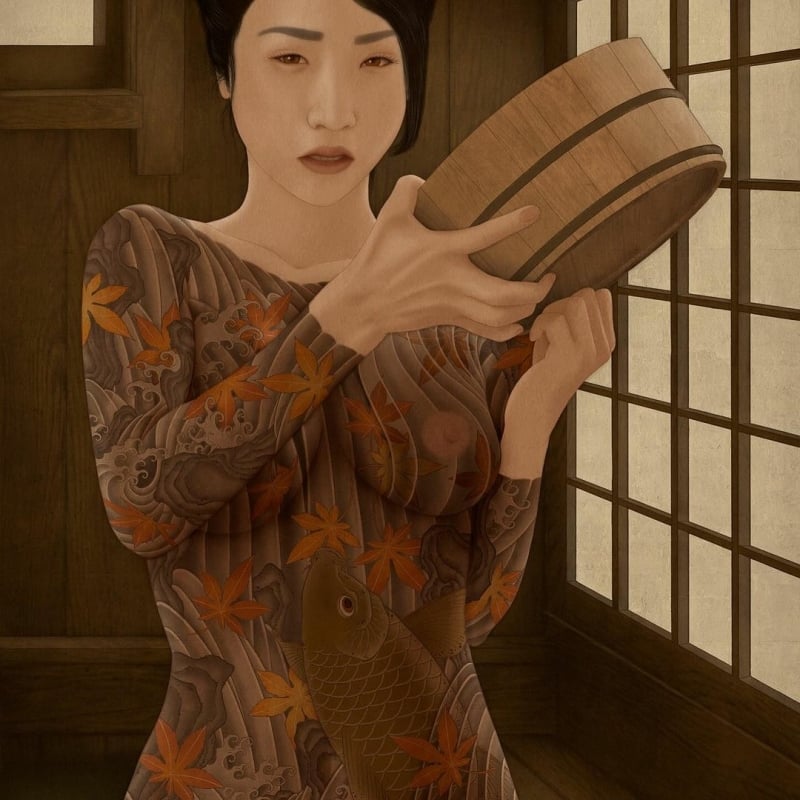
Fig.6a
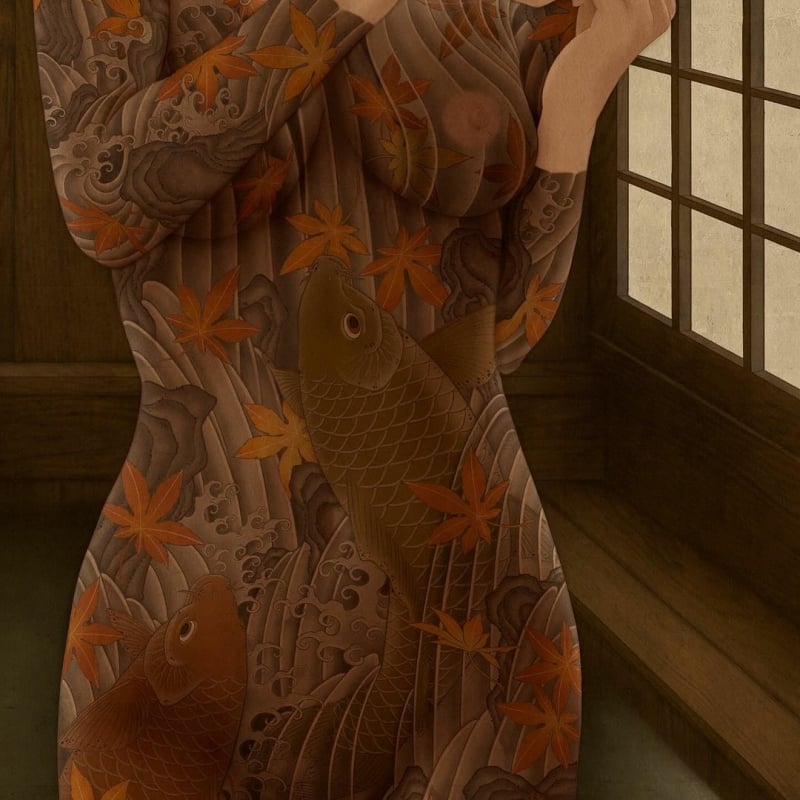
Fig.6b
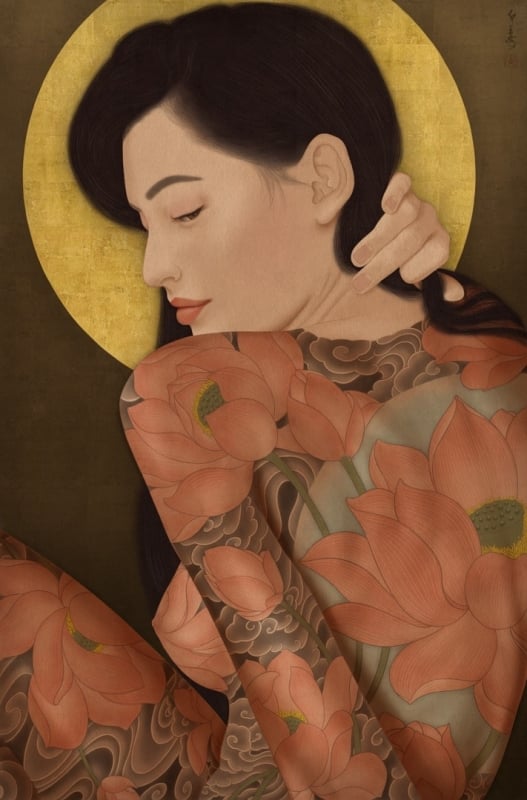
Fig.7. Hasu (Apr 2024)
Grey-Black Mud
The lotus flower begins its life in darkness, deep down in the grey-black mud beneath the murky waters of the pond. Slowly, slowly, it shoots upward, shedding its original habitat, breaks through the surface of the dark water and bursts in to full and beautiful bloom. In Buddhism, it is used to illustrate the journey, possible for each and everyone, from delusion and suffering to liberation and, ultimately, true existamce. In irezumi, the traditional Japanese tattoo, Buddhist designs of many different kind are often used, and the lotus can be seen as the throne upon which the various buddhas sit.
Various Buddhas
In this new work, titled ”Hasu (sacred lotus)”, I have chosen to make the lotus flower itself take center stage on her back, thus becoming all the Buddhas turned into one. The various Buddhas should not be seen as separate and individual, but rather as varioous aspects of our true and original human nature. The way we are born, perfect and complete, and to where we can return by seeing through the construction so wrongfully called ”reality”. As I work along this old new path, I am find myself further and deeper immersed in the act of creating. This beautiful, frustrating, painful, joyous and liberating path of becoming what I always were.
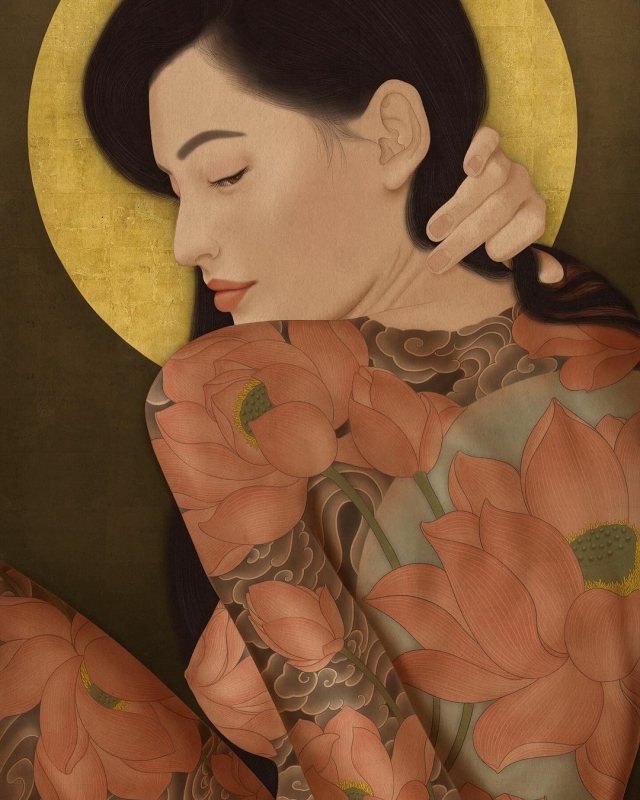
Fig.7a
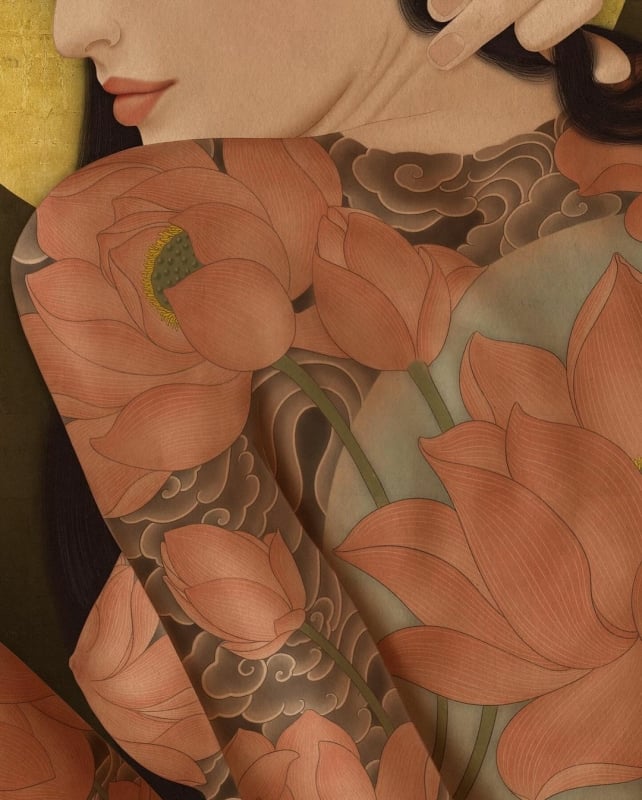
Fig.7b
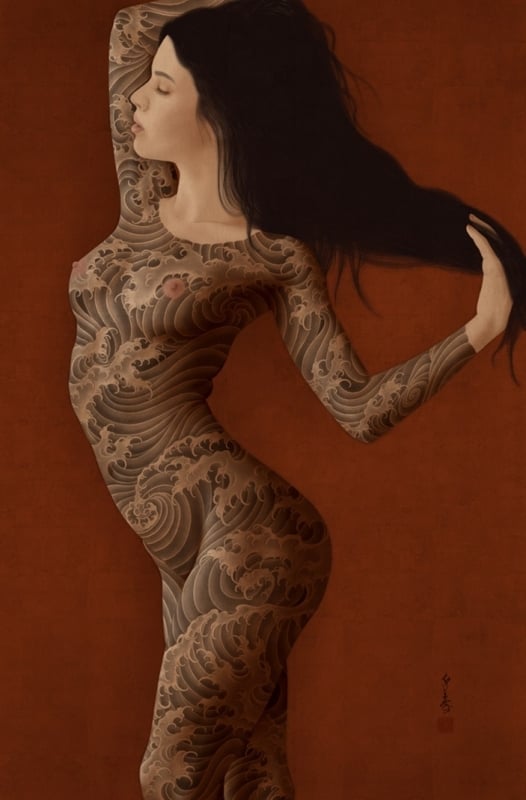
Fig.8. Nami (May 2024)
Mythical Character
Did you know that designing a traditional Japanese irezumi full body tattoo using only background is much more difficult than if also using an animal or perhaps a mythical character? For a number of years now, I have contemplated on how a bodysuit depicting only water would look. Would it be possible to even make it work? We are so used to seeing elaborate Japanese tattoos showing dragons, heroes, masks or buddhist imagery, in which water or wind are used to great effect to emphasize the main design motif, but turning the standardized background into the main focus point?

Fig.8a
Wave Designs
A wise old irezumi master once told me that waves and clouds are of as much importance that any dragon or flower, and should not be viewed as simply background. One have to take great care when designing and balancing all the elements of a full body tattoo. Before I began painitng ”Nami (wave)”, I first went back to study Japanese water and wave designs by master artists like Hokusai, Hiroshige and Jakuchu. I was determined to try to push my water design even further ( I have been designing for irezumi for about 24 years now), and I soon discovered that my project would go on to test my artistic perserverance. In the end, it would take me about three weeks of hard work to arrive at the piece you now see. I paint for at least 4-5 hours almost every day of the week, and the process of creating ”Nami” truly had me on the ropes more than once.
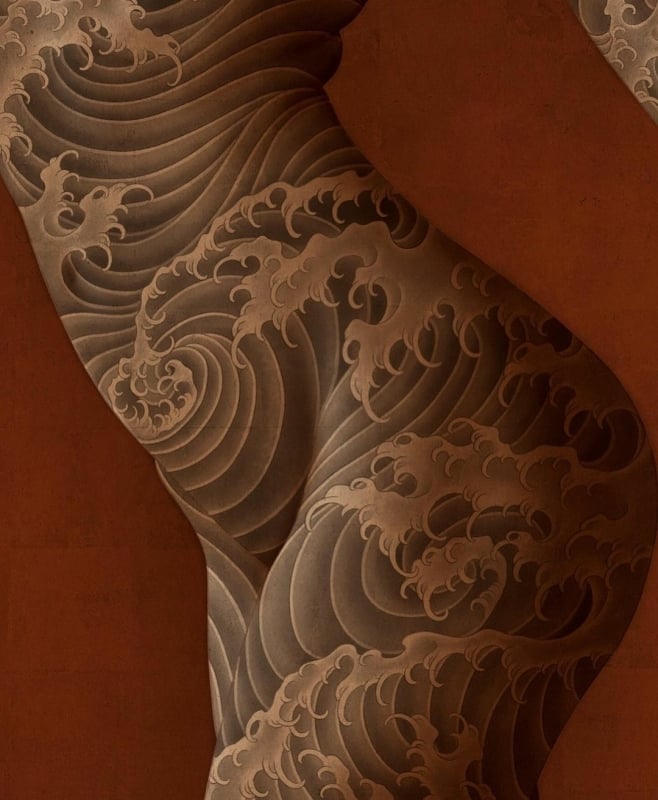
Fig.8b
4 Days
My mindset is an important key to be able to see it through. I never use words like ”fail” or ”do again”. Instead I think ”learning” and ”continuing”. That works well for me. If you spend the necessary time on your art, you will eventually get there, and often further than you first thought! If a painting takes 4 days to paint, that is quick! If another painting takes 4 weeks, or 4 months, that is also quick! That is purely because everything will undoubtedly take just as long as it takes! When creating, forget about speed. Just focus on what you are doing in each and every moment.
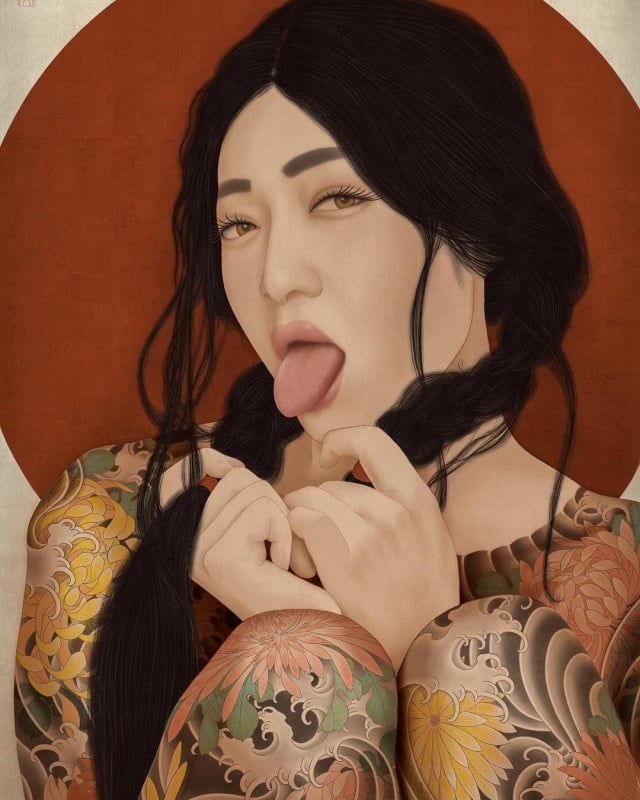
Fig.9. Hanako (May 2024)
Carefully Crafted Illusion
Change is inevitable. There is nothing you can do about it. Everything will change from one second to the other, just like it has always done, since the dawn of the Universe. Isn’t it strange how much we fear this one and only certain thing in our lives? We strive with our utmost strength to create a life that is unchanging. We are desperate for security. Schedules, plans, calendars, education, career, work, relationships… And it’s all a carefully crafted illusion. We go through life thinking that we can be safe. We will never be. The sooner we accept that, the sooner we can truly start living, fully and beautifully. In art, change is your best friend. It brings you little gifts and surprises, like a cat bringing home a dead bird, leaving it on the porch for you to find.
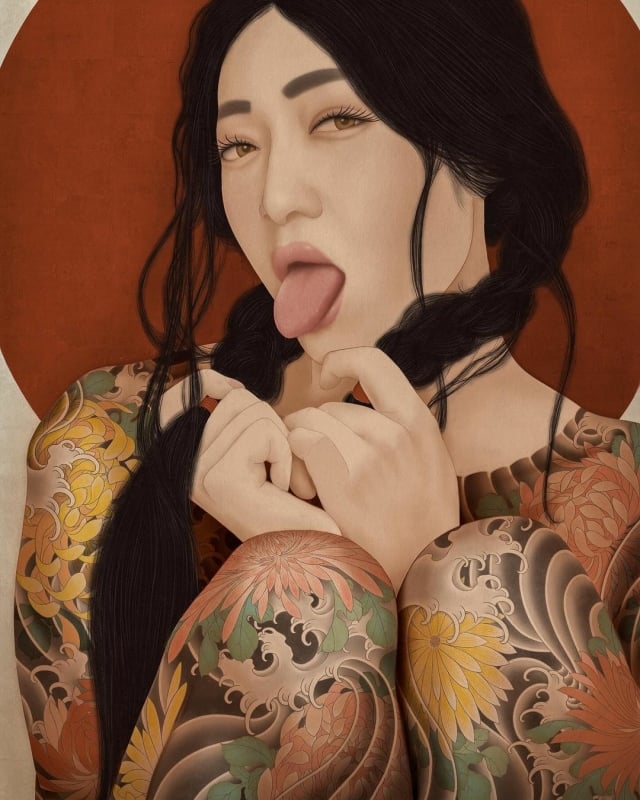
Fig.9a
Every Imaginable Ingredient
Change, proud like a child who just baked a cake out of every imaginable ingredient they could find in the cupboards, will always offer something beyond what you could ever imagine. Do not think about what people will possibly think about the way your art changes! Some of your audience will inevitably part ways with you. This is not a sad thing. Just like the seasons, there is a time for everything. While some take their leave, others will discover you. You too will stop loving some things and find other, new pleasures to keep you awake at night. Just like it has been since the dawn of time. ”Hanako” is my latest painting.
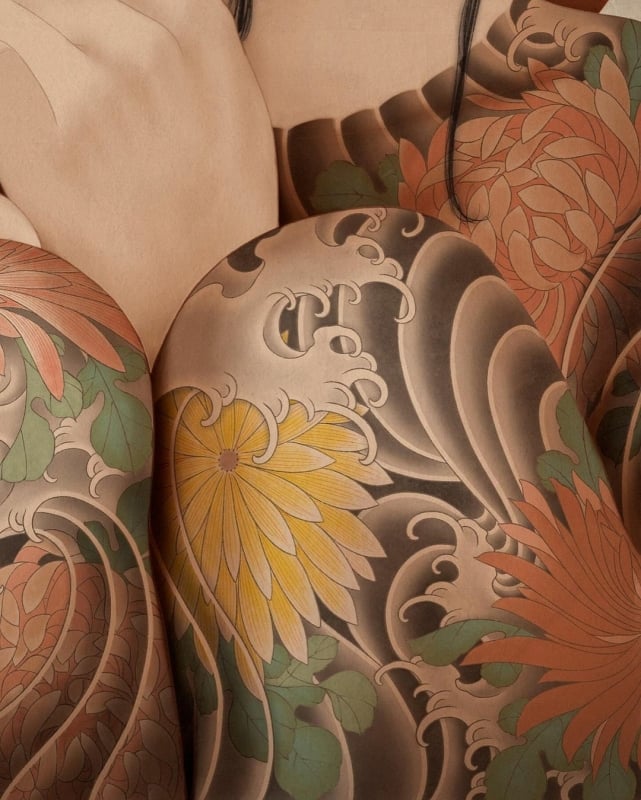
Fig.9b
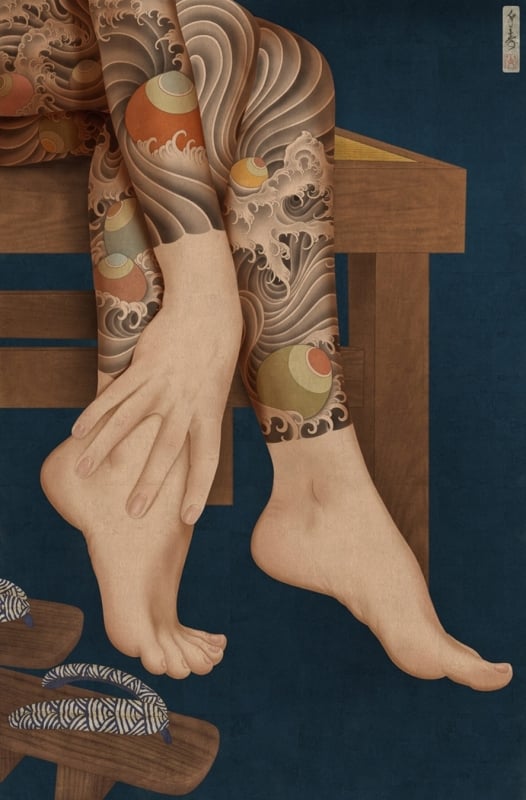
Fig.10. Tama (May 2024)
Rythm
In Japanese, ”Friday” is ”Kinyoubi (golden day)”, and I love how that truly says how I feel about this best of days! For some reason, I often seem to reveal my latest artwork on Fridays. It’s not something intentional, but it seems like seven days of hard work is what it takes for me to create a new piece. Funny how creation finds its rythm if you just let it. Since Kinyoubi is also a day when I allow myself some fine sake, cold beer and a homecooked Japanese meal,
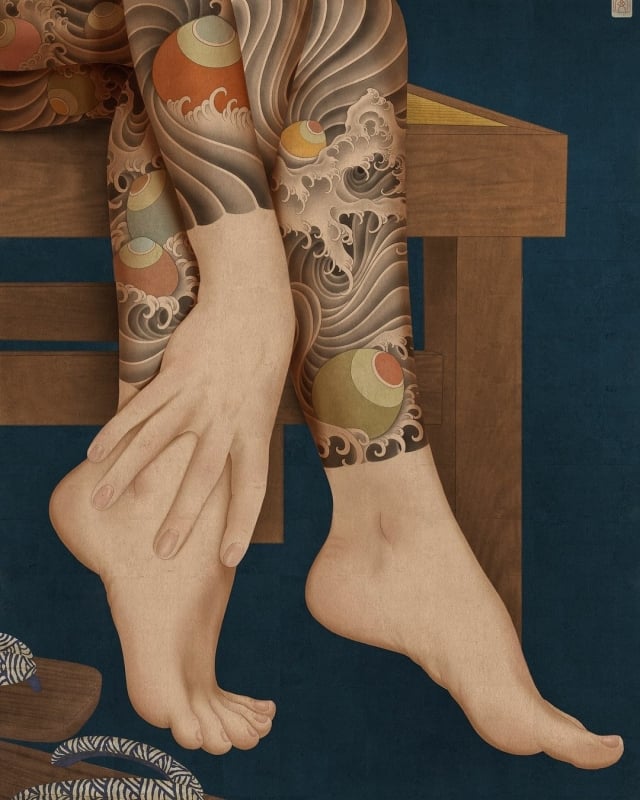
Fig.10a
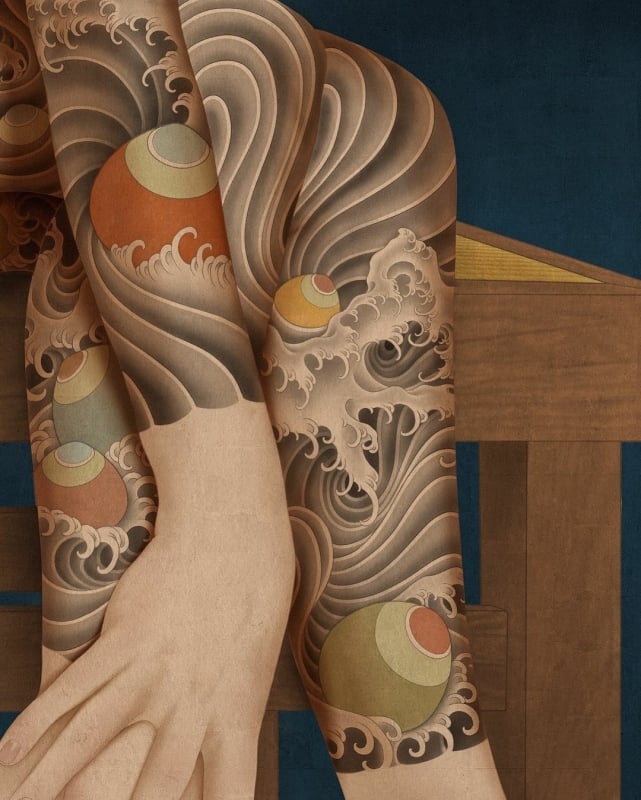
Fig.10b
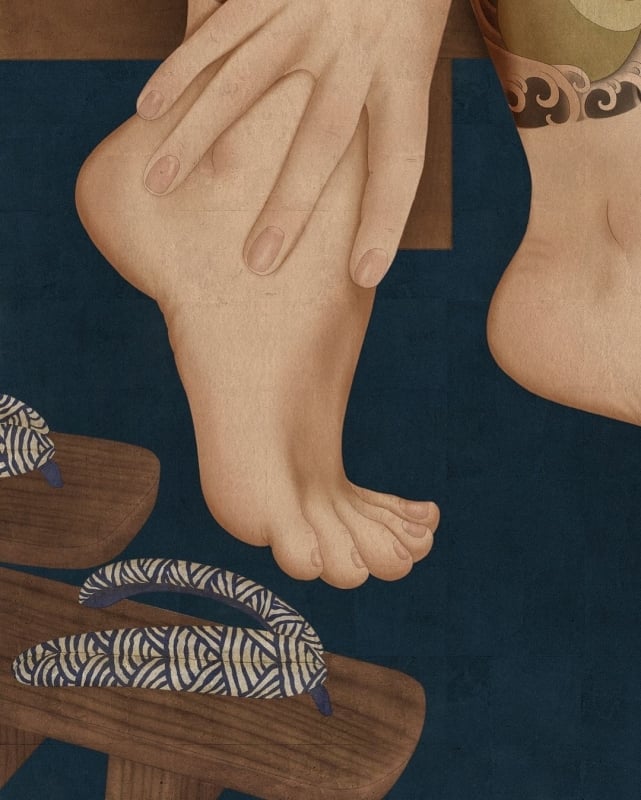
Fig.10c
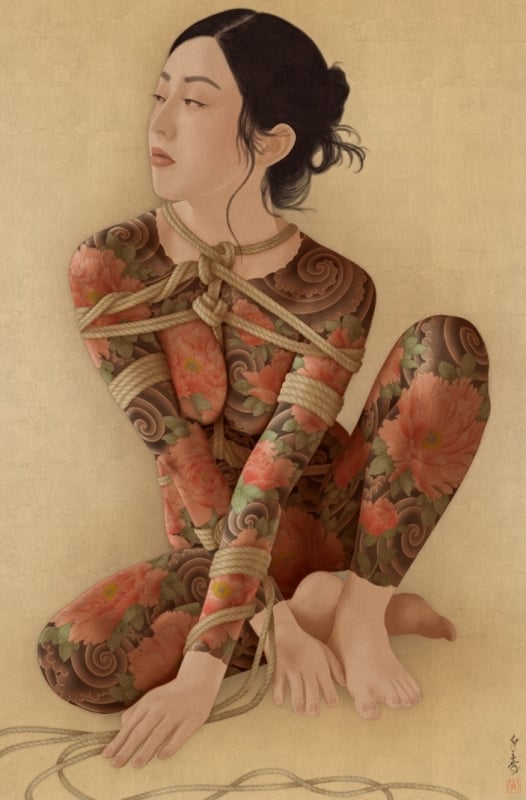
Fig.11. Kinu (June 2024)
Otherwordly Courage
”Kinu” means ”silk” in Japanese. It refers to the unique sheen human skin takes on when adorned with IIrezumi, the traditional Japanese tattoo, thus becoming a beautiful brocade. Just like with painting, digital or analogue, Irezumi is conjured up from nothing and transforms into a miracle, a poetic impossibility. Think about that for a second…. where does art come from? A flash of….something, inside of someone, then captured and given through the arranging of colors on paper, canvas, screen or skin. It is truly a vision, a dream, air, manifested physically through hard work, frustration, turmoil and almost otherwordly courage. For you who have followed my artistic progress, the above composition might seem familiar. I have used the same photo reference for two earlier works, and now, as I have so suddenly taken a great leap in my artistic evolution, I couldn’t resist the urge to see how she would manifest a third time around.
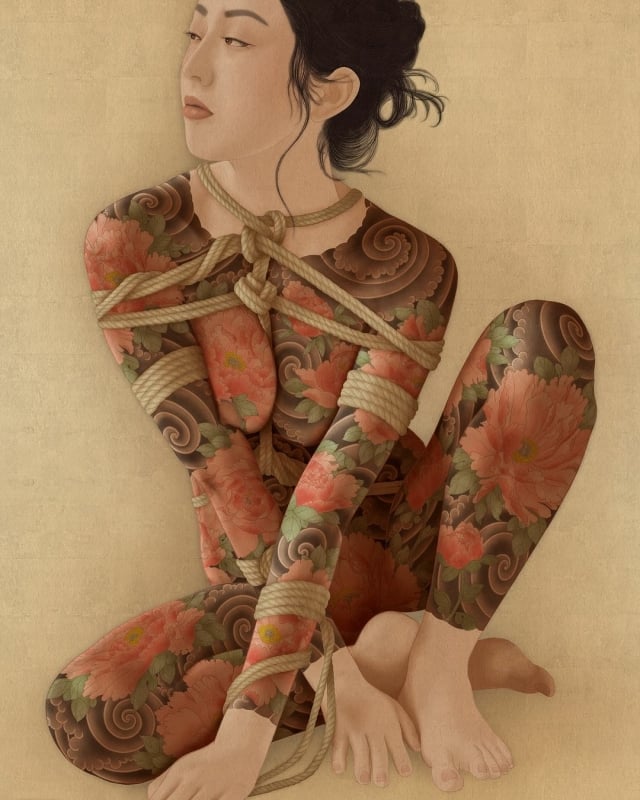
Fig.11a
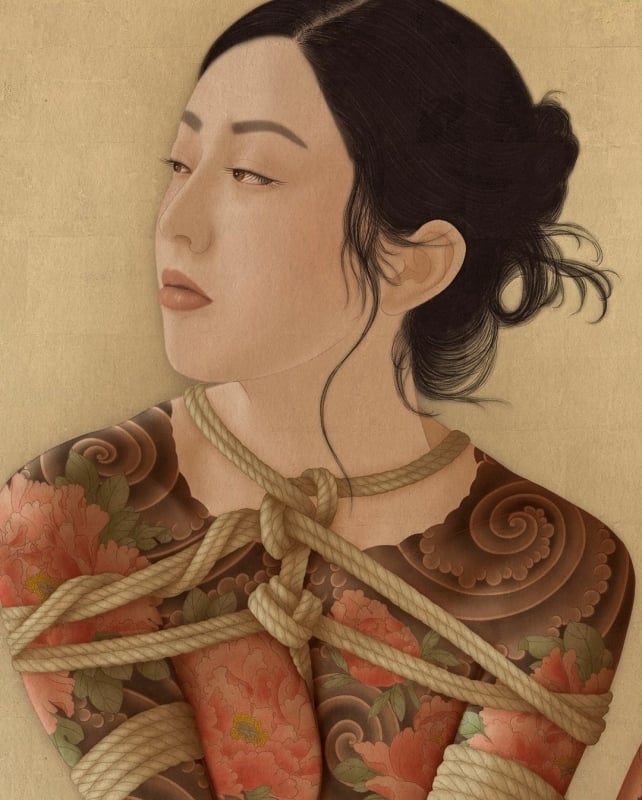
Fig.11b
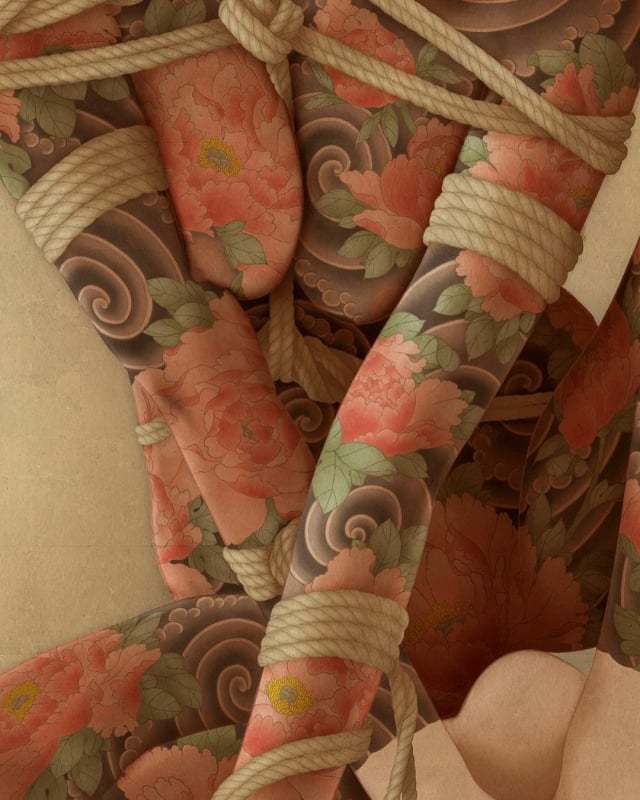
Fig.11c
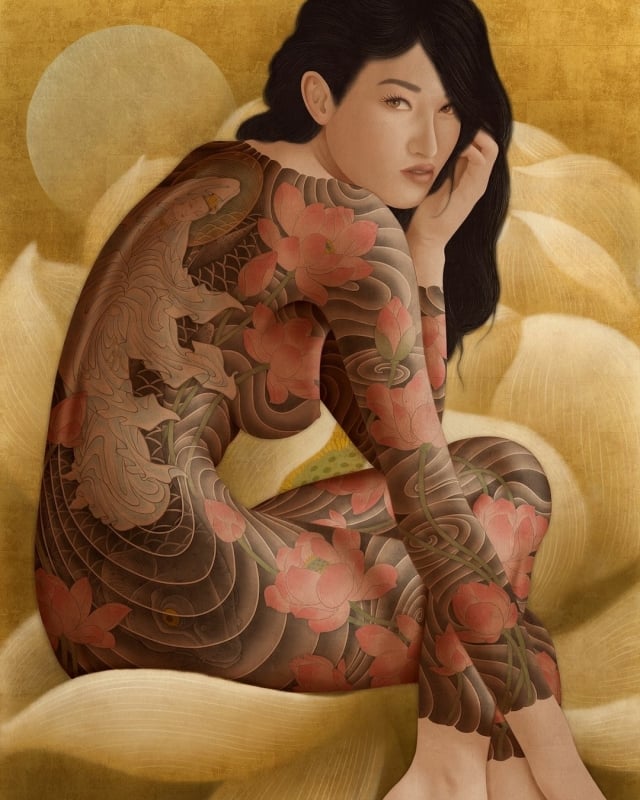
Fig.12. Kayou (Lotus Leaves), June 2024
Mournfully Cawing
"I remember the lotus leaves in Shinobazu pond. It was in May, and their flowers were still resting dormant and out of sight. The murky waters of the pond was almost completly hidden by vibrant field of deep green, large leaves, swaying gently as the late spring breeze chased playfully through them. The Lotus provides us with so much beauty. From the green buds that rise ever so slowly from beneath the dark mud, breaking through the water’s surface and then reaching for the blue sky, to the blackish brown decaying forest they become as summer draws to an end. I adore and their every incarnation. Beneath the leaves, among the thick stems burrowing into the darkness of the water, swims bronze-black carp and wise old turtles. Above water, you can some times spot a kingfisher and certainly there will be a few herons standing around. Above it all, black and mournfully cawing, circles the crows of Ueno park. So many poems.."
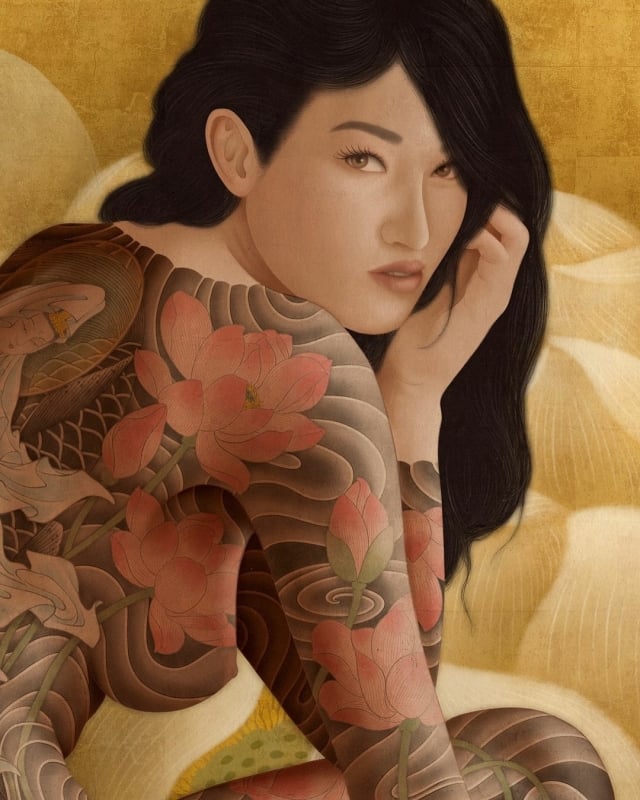
Fig.12a
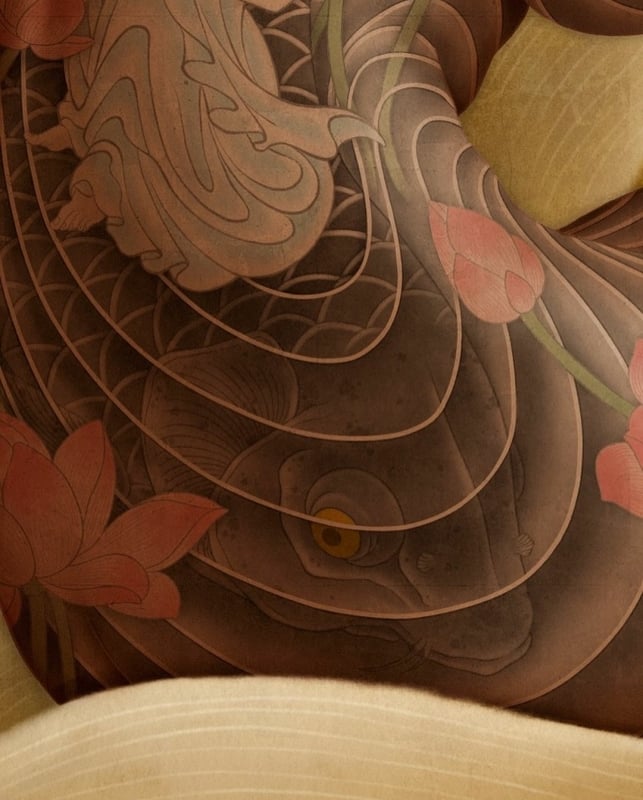
Fig.12b
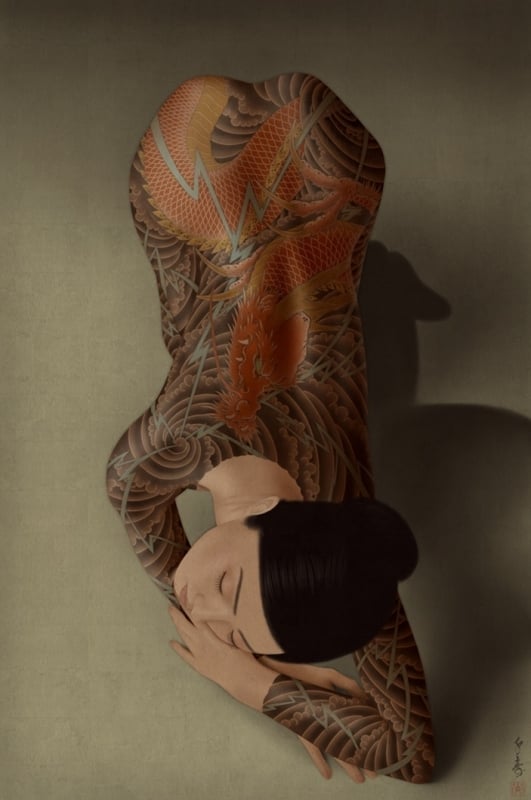
Fig.13. Tatsu (Dragon), July 2024
Kaleidoscopic Patterns
Can you be fully dressed without wearing a single thread?
Over the years, the irezumi photography of Masato Sudo (google his work) has affected my visual perception of the traditional Japanese tattoo perhaps more than anything else. In 1985, he published a legendary photo book titled ”Ransho”. It was something completely new and beautiful. Instead of simply documenting Japanese full bodysuit tattoos like a painting on the wall, he created living collages by posing tattooed people together, forming kaleidoscopic patterns and almost surrealistic visions against a black or light grey background. He showed that the tattoo is neither on you or in you - it IS you. This sense of blurring borders and boundaries, like an octopus shifting color and pattern on a whim, has never left my thinking when it comes to Irezumi. This painting, ”Tatsu (dragon)”, is a tribute to his groundbreaking work.

Fig.13a
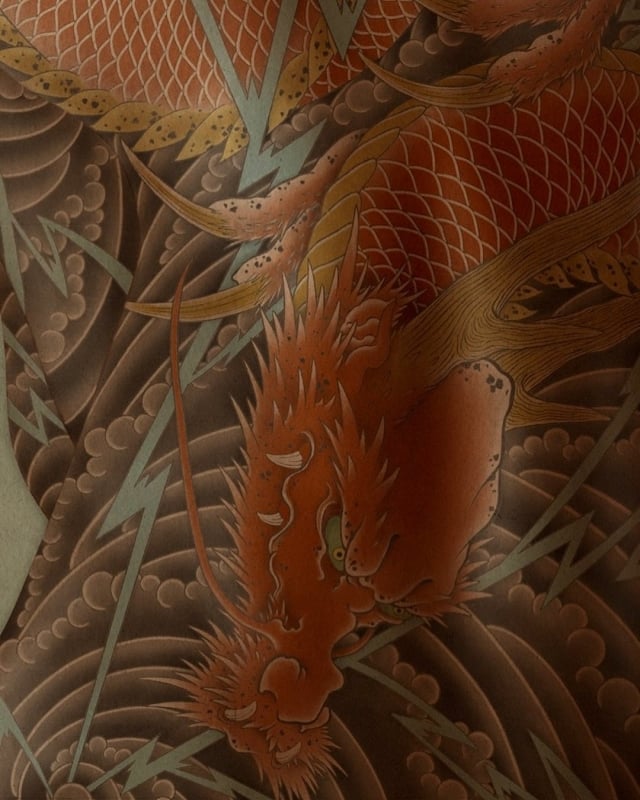
Fig.13b

Fig.13c
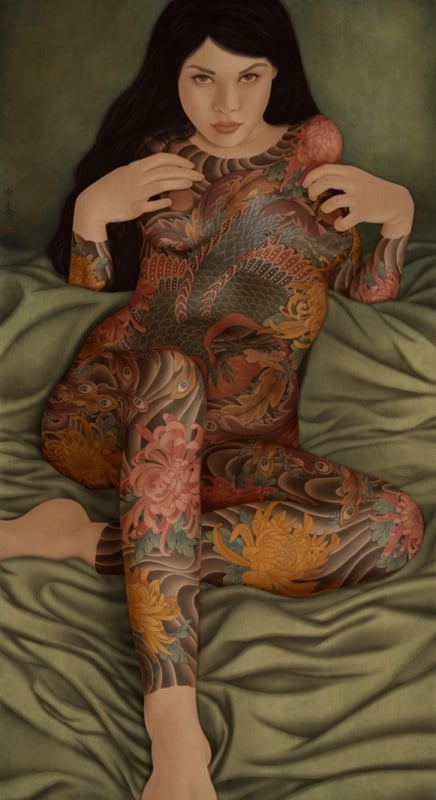
Fig.14. Yasu (Aug 2024)
Ho-o Design
Designing for traditional Japanese Irezumi tattoos is a complex process, and some designs and placements require more thoughts than others. This Ho-o design (often incorrectly referred to as a Phoenix) has such a great potential, as the wings and tail feathers can be used to enhance and beautify almost any part of the human body. The front torso placement in my painting was more difficult than I had ever expected, and altogether this painting took more than 6 weeks to complete. When creating art it is a good thing to learn to truly appreciate the trial and error process. It is your best friend. And just like in real life, some friends can visit you very often.

Fig.14a
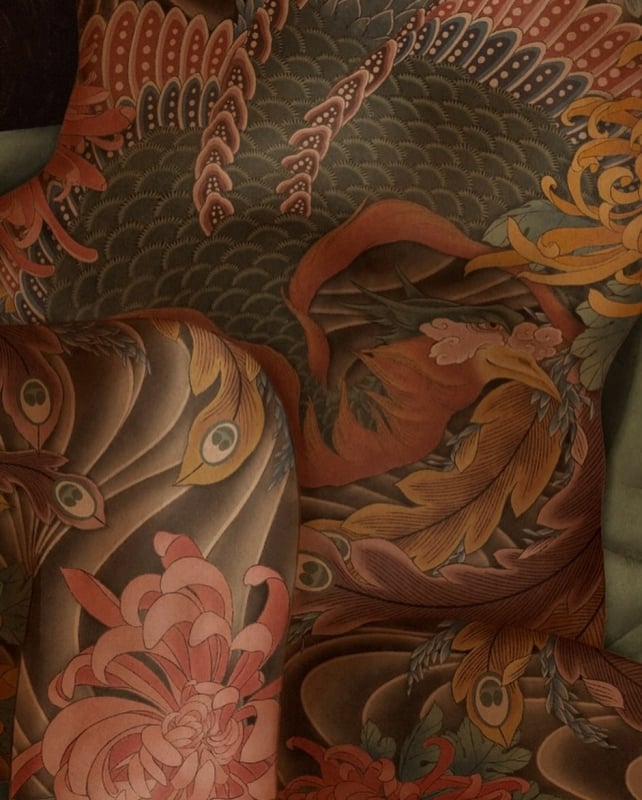
Fig.14b

Fig.14c
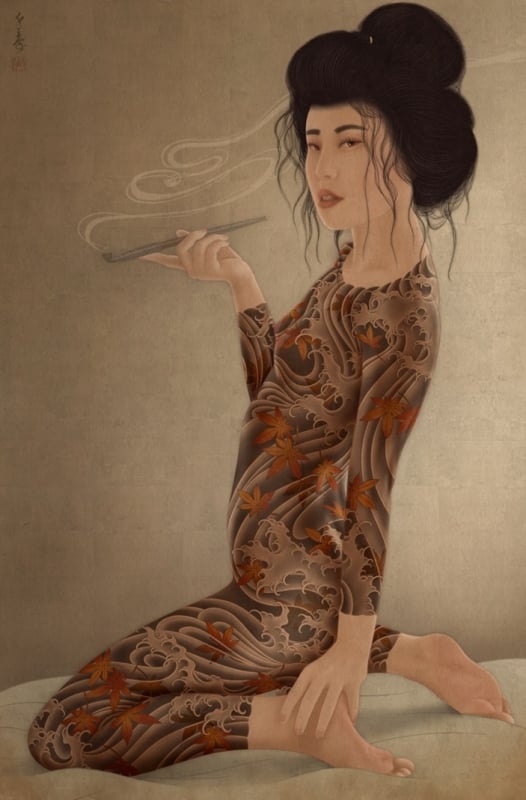
Fig.15. "Momijigari (viewing the autumn maple leaves)” (Sept 2024)
Old Stories
Suddenly, I realised that not only am I painting in order to make exhibitions and prints, but all the artworks in this new series of Irezumi Bijinga (portraits of beautiful tattooed women) also serve as a sort of look-book for what type of tattoo work you can expect from me. During my more than 20 years devoted to traditional Japanese tattooing, I have constantly strived to find new ways to express old stories. That has also now began to heavily influence my desire to design Irezumi tattoos that truly fit the wearer. Traditionally, Irezumi has been a male affair, and even though most of the designs can be described as unisex, I feel that much more can be done to fit the motifs to specific bodies and persons. First and foremost, I am interested in what can be achieved when specifically designing for the female body. And can the same unisex concept be applied the other way around?
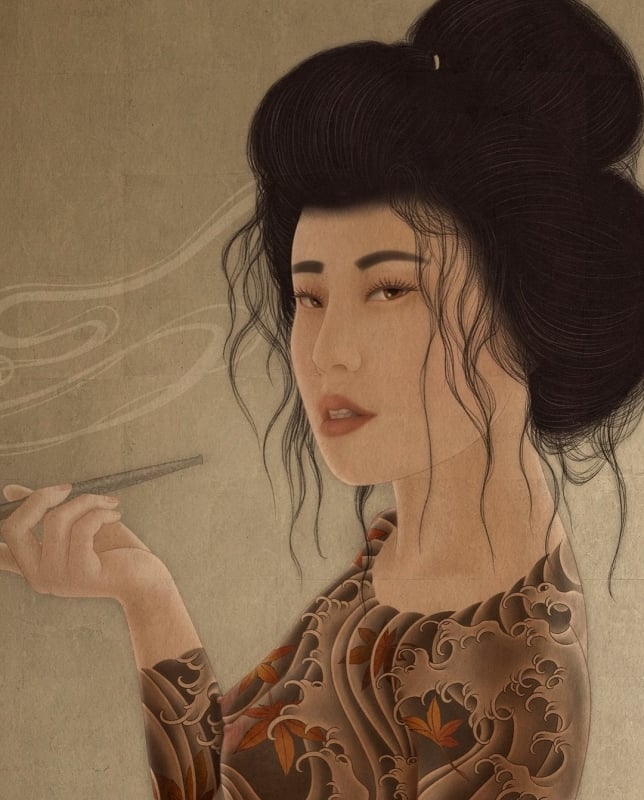
Fig.15a
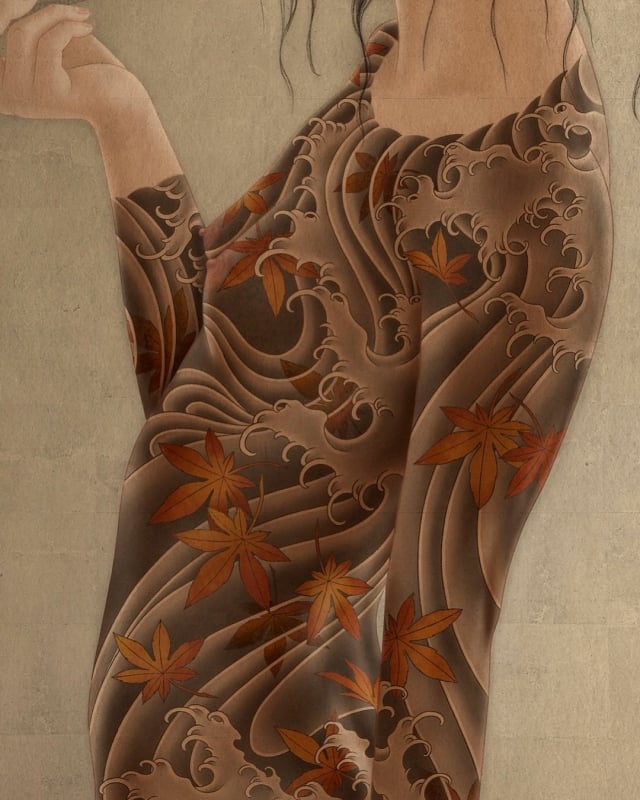
Fig.15b
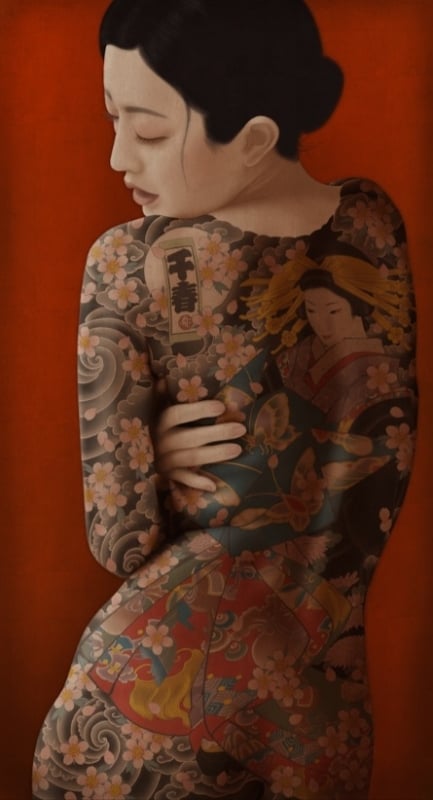
Fig.16. "Hanagumo" (Oct 2024)
Falling Like Snow
For this painting, I chose the theme of Oiran (high ranking Yoshiwara courtesan) and sakura fubuki (cherry blossoms falling like snow). It's a rather unusual Irezumi design, but you can find it sometimes on Meiji era photographs of tattooed people. For you really want to spend a long time with a design, then this is the perfect one. No shortcuts or easy parts. Just focus and hard work. And thorough research, of course. Never just randomly use a design you don't know well. Then it just becomes a useless picture among all the other useless pictures.
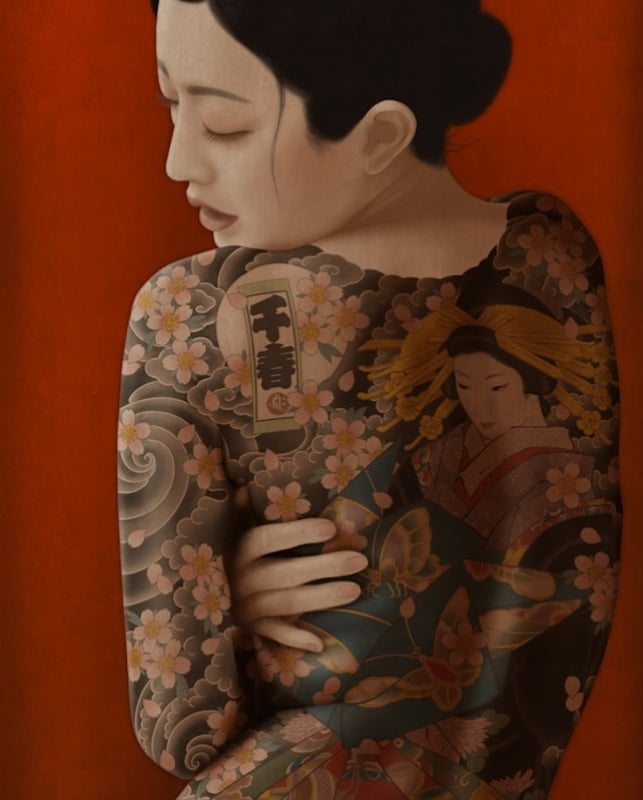
Fig.16a

Fig.16b
Artistic Evolution
11 years of artistic evolution! The left one was painted in 2013 and the one on the right was completed recently (fig.16b). The difference is striking. This evolution does not come to you in one great leap. It is thousands of hours of constantly working. Not only do you have to hone your technical skills through an infinite cycle of trial and error, you also have to work very hard on how to interpret and capture your own artistic vision. This can only be done through constant study. Not only of Japanese art, but also of history , culture, religion, spirituality…
Slowly it forms a whole, a treasure box from which you will be able to pull Jewels. Still, the process continues in all its ruthless beauty. I can with certainty say, that through all this a accumulation of knowledge and experience, I now know that the learning will be endless, and that even though I know a great deal, I know actually very little.
We'll be closely following Senju's development of this series and will include future designs to this page.
Click HERE for the influence of the Shin Hanga artist Shotei Takahashi on Senju Shunga
The above pieces can be obtained on the following page. (We're not an affiliate!)
